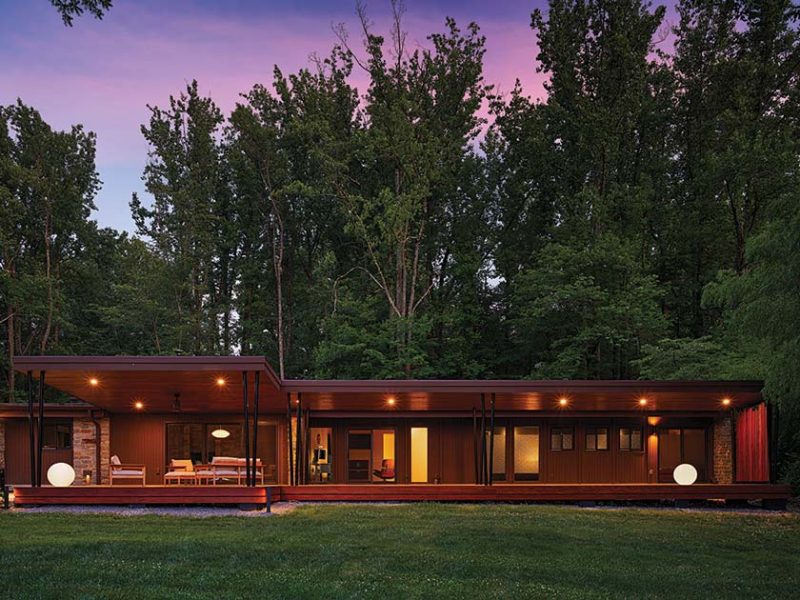An architect expands the outdoor living space of a mid-century Maryland home using natural materials—and lots of creative ideas.
Jeff and Cheryl Weiland loved living in their mid-century home, built in 1962 by M.J. Brodie, the renowned architect widely credited with revitalizing downtown Baltimore, Maryland. They also loved to host dinner parties and relax outdoors on their backyard patio, which offered a view of the home’s lush landscape.
However, the existing patio was small and in disrepair, so the Weilands felt that rather than just repair it, they should expand and redesign it to better suit their lifestyle. It was also important to them that the addition would look like an organic extension of their MCM home.
As a result, they contacted Laurie Stubb, AIA, principal at Place architecture:design (placearchitecture.com) to design and direct the porch expansion project.
“Jeff and Cheryl wanted a place to sit, relax, grill and entertain while enjoying the serenity of the landscape,” Stubb says. “They desired seamless access to the outside from each room along its length, along with a roof providing shade to enjoy the view of the yard. Using natural materials, we created an elongated porch to provide seamless access and flow between the indoor and outdoor spaces.”
Stubb points out that the house embodied a familiar ethos typical of its mid-century era.

“With 2,590 square feet of interior space and four bedrooms in a single story, the house is long and low, stretching across its 1.2-acre property. It appears as a ‘bar,’ with a low-pitched, linear gable roof and is clad in local fieldstone. Stone fins extend past the main house and sit under the rear overhang. Infill panels of vertical, painted, tongue-and-groove wood siding are spaced between the stone piers. On the interior, classic mid-century details include exposed ceiling rafters, large areas of glass and an open floor plan.”
The Architect’s Vision
With the homeowners’ request for universal access between inside spaces along the house’s entire length and new outdoor living spaces, Stubb knew the solution was going to be visually impactful. At the same time, she wanted a solution that would complement the existing mid-century design without overpowering it.

“We envisioned two porch spaces: the main gathering area just outside the breakfast room and the long ‘tail’ connecting the primary bedroom and office to the outside—ultimately providing all rooms with a clear path to a covered outdoor space,” she says.
The new exterior living space in the rear of the house stays true to the mid-century design principles of the house as if it were a natural extension, with defined spaces for entertaining and relaxing, Stubb explains.

“Our design followed the ‘rhythm’ of the stone fins. The long porch matches the width of the infill between the fins. The original 6-foot-wide sliding door from the breakfast area was replaced with a three-panel, 12-foot-wide sliding door that provides additional light to the interior and offers more direct connectivity between the interior spaces and the exterior porch environment.”
The Details of the Maryland Home Extension Project
The addition comprises three primary formal elements: the roof, its structural supports and the “living platform”—all composed to feel like a holistic, fully formed living space without walls.

“The form of the roof was critical to making this addition feel as if it were a natural extension, and the single-pitch roof slope recalls that of the existing roof,” Stubb says. “The roof has two sections: the larger zone above the seating group and the ‘tail’ that runs along the length of the house. Both extend upward and outward toward the yard, adding a bit of modern flair. Additionally, they provide maximum views and air circulation.”

The steel structural columns that support the roof were custom fabricated in a “V” shape, allowing for maximum long spans while enhancing the modern expression reminiscent of many mid-century column designs. The third element is the “living platform”—essentially, the elevated ground plane that runs the length of the house and sits directly beneath the continuous roof.

To achieve the holistic vision, it was important to craft the platform to feel like a monolithic floor surface, rather than a deck. The use of wood cladding on the underside of the roof and on the platform “stitches together the composition” and makes this environment warm and inviting.
The Context
The Towson, Maryland, climate presented a design challenge.
“Because we are in the Mid-Atlantic region, summers are typically humid and quite buggy,” Stubb says.“Initially, we thought to screen the porch to protect from the insects, but in the end, the clients prioritized the open feel of an unenclosed space. Large fans were added to induce plenty of air movement—which solved the problem.”


The team achieved its goal of creating an enhanced and enlarged outdoor living space that appears to be an organic extension—in both the use of natural materials and design—of the original MCM home’s architecture, while also making a powerful statement in its own right.
For more fantastic MCM architecture in Maryland, see A Mid Century Remodel in Maryland. And of course, don’t forget to follow us on Instagram, Facebook and Pinterest for more Atomic Ranch articles and ideas!












